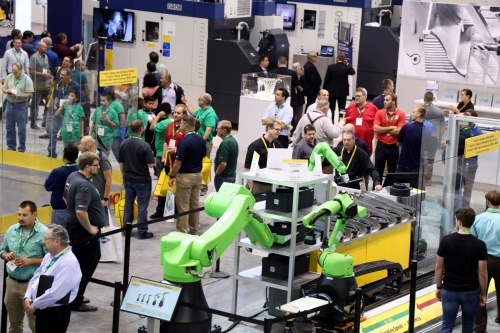Top Tech Trends to Transform Manufacturing
Manufacturing technology in the forefront at record-setting trade show
IMTS (the International Manufacturing Technology Show) is the largest machine-tool and manufacturing tech show in the Western Hemisphere. Held in even-numbered years at Chicago’s McCormick Place, the show regularly announces, displays and confirms numerous breakthroughs in production and production-related tech advances.

First, a few numbers. According to the show’s sponsor, the Association for Manufacturing Technology (AMT), IMTS 2018 was a record-breaker. The show opened September 10 to 1.4 million s.f. of exhibit space, comprising 2,123 booths representing 2,563 companies. This tops the 1,808 booths and 2,407 exhibiting companies at IMTS 2016, the previous historical high. It took 4,465 trucks to haul in more than 55 million pounds of machinery, with eight machines weighing in at more than 100,000 pounds. Pre-registered visitors exceeded 113,000, and the final number, 122,636, was also a new record.
The crowds and upbeat attitudes on exhibitors and attendees alike left no doubt that technology trends and a robust North American economy were driving potential investments in manufacturing technologies. Here are a few highlights:
The Digital Transformation
One overarching theme of the show was digital data collection. Whether show visitors wanted to look at machining centers, tooling, inspection equipment or a number of seemingly mundane components such as gears, valves, motors and drives, it seemed all the exhibitors were touting how their equipment could gather operational data and share it up and down your production operation.
Certainly the days of clipboards and manual data collection are being buried alongside ordering components and parts out of print catalogs. One exhibitor, Misumi USA, sources and produces thousands of machine and part components such as springs, fasteners, clips, valves and more. For CAD (computer-aided design) component and machine designers, the company was announcing Rapid Design, a free software suite that allowed users to configure more than 80 sextillion configurations of digital Misumi components. In addition to saving vast amounts of time compared to ordering out of print catalogs, Rapid Design users are assured their parts fit their design needs by importing 3D models along with pricing, global part numbers and component availability.
Automation
Another display hosted by the National Institute of Standards and Technology (NIST) combined a CNC (computer numerical control) vertical machining center and a coordinate measuring machine (CMM), each served by the same collaborative robot. Not only did this demonstrate ever-evolving means of machinery automation, it showed how the measurement data from the CMM was fed back to the CNC milling machine for real-time adjustments to increase surface finish or other quality requirements. The process of cut, then measure, then adjust, then cut again, is also being consigned to those companies willing to be outperformed by modern producers.
Addressing show-goers on the opening day, AMT president Doug Woods not only confirmed the IMTS focus on technology such as computer numerical control, but he also said the levels of technology on display were unprecedented. It is no longer just individual machines with digital controls, but entire networked systems with big data collection and analysis. Conventional metal removal is becoming more efficient as a result. At the same time, emerging technologies like additive manufacturing or 3D printing are getting attention from startups and traditional machine tool builders alike. A number of hybrid machines capable of traditional metal removal and additive manufacturing in the same setup were on display.

3D Printing
There were non-traditional exhibitors entering the manufacturing space at IMTS, mainly in emerging technology categories. HP Inc., the largest maker of personal computers, was making a big push into the manufacturing industry with its first printer that can print 3-D metal parts, the Metal Jet.
Engineering firm GKN Plc is using the printers in its factories to produce parts for companies including Volkswagen AG, one of the biggest automakers. GKN makes more than 3 billion components a year and expects to print millions of production-grade parts on Metal Jets for customers as early as next year, GKN said in a statement.
“We are in the midst of a digital industrial revolution that is transforming the $12 trillion manufacturing industry,” HP Chief Executive Officer Dion Weisler said. “HP has helped lead this transformation by pioneering the 3-D mass production of plastic parts and we are now doubling down with HP Metal Jet.”
Printers that make three-dimensional metal objects already exist, but HP said Metal Jet can produce a lot more parts at “significantly” lower cost than existing machines. Stephen Nigro, HP’s president of 3D printing, was more cautious than his boss saying it will be at least five to 10 years before the unit generated a material share of HP’s sales, which topped $50 billion last year.
At very high volume, other manufacturing methods are more economical. Still, Nigro said it’s one of HP’s best shots to bolster its future. “We needed to come up with a disruptive or winning technology,” he said. “We need to have a vision that’s not just compelling today, but in the future.”
And not surprising, it was announced at IMTS. Technology on a number of fronts is making manufacturing a compelling and exciting place to be.
Some opinions expressed in this article may be those of a contributing author and not necessarily Gray.
Related News & Insights
Manufacturing, Construction
Advancing Apprenticeships for Improved Workforce Training
Industry, Opinion
Food and Beverage, Engineering
The New Face of Manufacturing: InLine Engineers
GrayWay, Industry
Distribution, Construction
Manufacturing Convergence and the Industrial Internet of Things
GrayWay, Industry
July 11, 2018